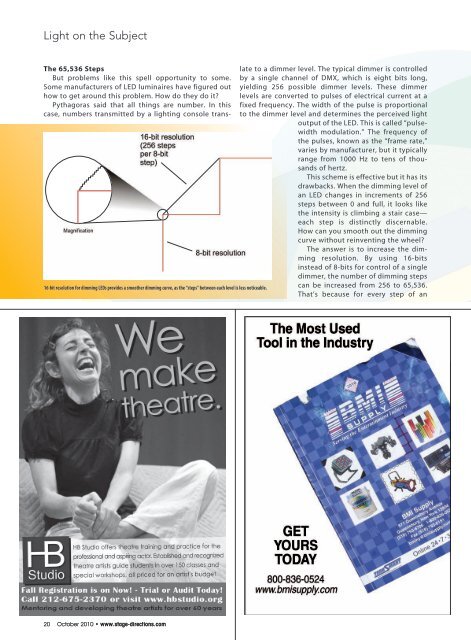Download a PDF - Stage Directions Magazine
Download a PDF - Stage Directions Magazine
Download a PDF - Stage Directions Magazine
You also want an ePaper? Increase the reach of your titles
YUMPU automatically turns print PDFs into web optimized ePapers that Google loves.
Light on the Subject<br />
16-bit resolution for dimming LEDs provides a smoother dimming curve, as the “steps” between each level is less noticeable.<br />
The 65,536 Steps<br />
But problems like this spell opportunity to some.<br />
Some manufacturers of LED luminaires have figured out<br />
how to get around this problem. How do they do it?<br />
Pythagoras said that all things are number. In this<br />
case, numbers transmitted by a lighting console translate<br />
to a dimmer level. The typical dimmer is controlled<br />
by a single channel of DMX, which is eight bits long,<br />
yielding 256 possible dimmer levels. These dimmer<br />
levels are converted to pulses of electrical current at a<br />
fixed frequency. The width of the pulse is proportional<br />
to the dimmer level and determines the perceived light<br />
output of the LED. This is called “pulsewidth<br />
modulation.” The frequency of<br />
the pulses, known as the “frame rate,”<br />
varies by manufacturer, but it typically<br />
range from 1000 Hz to tens of thousands<br />
of hertz.<br />
This scheme is effective but it has its<br />
drawbacks. When the dimming level of<br />
an LED changes in increments of 256<br />
steps between 0 and full, it looks like<br />
the intensity is climbing a stair case—<br />
each step is distinctly discernable.<br />
How can you smooth out the dimming<br />
curve without reinventing the wheel?<br />
The answer is to increase the dimming<br />
resolution. By using 16-bits<br />
instead of 8-bits for control of a single<br />
dimmer, the number of dimming steps<br />
can be increased from 256 to 65,536.<br />
That’s because for every step of an<br />
20 October 2010 • www.stage-directions.com

















